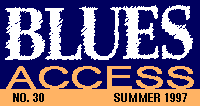|
Shrink-wrapping albums must be about the least glamorous task
in the record business, but find Bob Koester on an average work
day and he's just as likely to be doing that as supervising
a recording session.
It's been a long time since Delmark Records was a one-man
operation and he had to do everything, but the dean of
Chicago blues and jazz recording still works a six-and-a-half-day
work week and continues to ungrudgingly perform what he calls
the "shit work" of the business. As someone who has
hand-built and kept afloat an independent label for more than
40 years, Koester knows well that success and survival require
close attention to the details. Or as he puts it, "I'm
not an employee, so no job is a menial task."
Koester doesn't get out to see live music as much as he
used to, but as someone who's been actively checking out
and recording the jazz and blues arena for the last five decades
he's got enough memories to supply an army of music fans.
The artists he has waxed over the years make up a real "Who's
Who" of the blues world: Magic Sam, Otis Rush, Roosevelt
Sykes, Jr. Wells, Buddy Guy, Robert Jr. Lockwood, Jimmy Dawkins,
J.B. Hutto, Big Joe Williams, Arthur "Big Boy" Crudup,
Carey Bell, Luther Allison, Yank Rachell, Sleepy John Estes, just
to name a few.
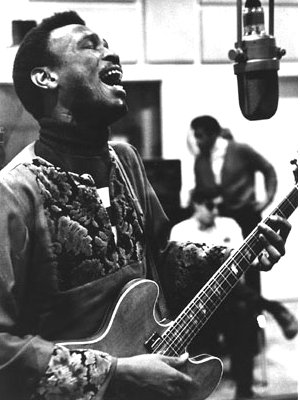
Magic Sam
On the jazz side, Delmark runs the spectrum;
its catalog -- equally as large as the blues catalog --
contains everything from vintage New Orleans jazz to pioneering
recordings of the '60s Chicago avant-garde movement.
Although many of the greats Koester has recorded have passed on
to blues heaven, he's not stuck on the "good old
days" -- there's still too much recording to
be done. Delmark has benefited from the recent blues resurgence
and has expanded both physically -- the Delmark House, with
its 24-track studio, was purchased five years ago -- and
in terms of its catalog, which is growing rapidly in both number
and diversity.
Since the purchase of the new studios on the North Side five years
ago, Delmark's rate of releases has increased dramatically,
and the annual output (including CD releases of catalog material)
now equals about what the label released in its first decade and
a half. Because of serious economic problems throughout the '80s,
a decade when Delmark released little new product, it has been
late in reissuing back catalog on CD. This process will soon be
complete, leaving that much more room available for new recordings.
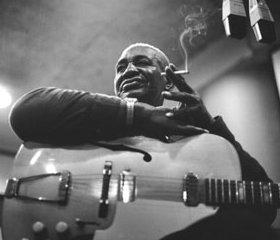 Arthur "Big Boy" Crudup
Arthur "Big Boy" Crudup
The size of Delmark's staff has expanded to five full-time
workers, including Susan, Koester's wife of more than 30
years, who had worked part-time for the label for years before
hanging up her social-work job several years back, and Steve Wagner,
in-house producer and Delmark's manager since 1987. Koester
has put his full trust in Wagner to run the operations and points
to Wagner's management skills as one of the most important
elements to Delmark's success in recent years.
One of the main reasons for Delmark's ability to survive
as an independent label in a field which sees so many go under
-- aside from consistently high quality records and artists
-- is the downtown Jazz Record Mart (JRM),
which Koester acknowledges is his "bread and butter." Stocked with
perhaps the broadest range of jazz and blues compact discs anywhere,
the store also has a large selection of new vinyl, including Delmark's
back catalog as well as thousands purchased by Koester at bargain
rates following the introduction of the compact disc.
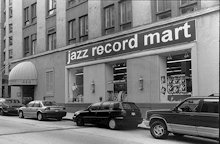
If there is a center to the blues scene in Chicago it is here,
at 8,000 square feet the "largest jazz and blues record
store in the world" and a mecca for out-of-town blues visitors.
The new location on Wabash Street is just around the corner from
the 7 and 11 West Grand Street locations that housed the JRM operation
(and Big Joe Williams, who lived in the basement at 7 West Grand)
since the early '60s. The new, modern facilities lack the
funky atmosphere of the last two locations, but after 40 years
of cramped working space, leaky roofs, damp basements and uneven
floors, Koester isn't sentimental about the change.
Over the years the JRM has served as a training ground for many
jazz and blues producers, writers and label owners, and in this
regard it is difficult to overestimate Koester's role in
shaping the last four decades of blues recording and documentation.
Living Blues magazine was started, with seed money from
Koester, in the basement of the JRM by a group that included employees
Amy van Singel, Bruce Iglauer and Paul Garon, while the Delmark
operation became the blueprint for how to run an independent label.
Blues label owners who got their start after having learned the
ropes from Koester as JRM employees include Iglauer, who recorded
his debut Hound Dog Taylor album for his Alligator label while
working at the Mart; the late Pete Welding of the Testament label;
Don Kent of Mamlish; the late Bruce Kaplan of Flying Fish; Pete
Crawford of Red Beans; Amy van Singel of Rooster Blues and Michael
Frank, whose Earwig label perhaps most closely follows Koester's
tradition of recording older, less-commercially viable artists.
Last year Koester's role as a mentor and pioneer in the
independent record business was formally recognized when he was
elected into the Blues Foundation's Blues Hall of Fame.
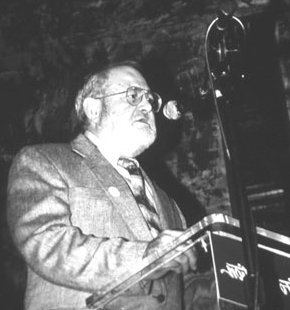
Koester accepts 1996 Handy Award
|
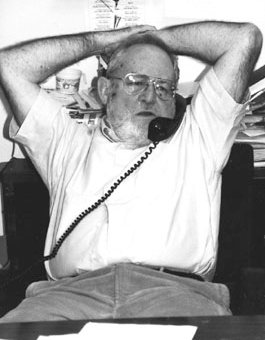
|
The history of Delmark Records
stretches back to 1953, when Koester
began selling jazz 78s by mail from his college dormitory room
in St. Louis, but he traces his lifelong passion for jazz and
blues back to a live radio broadcast of Fats Waller he heard as
an 11-year-old in Wichita, Kansas. The young Koester was soon
haunting local record bins and seeking out the occasional live
show, and among the acts he recalls with enthusiasm are the Count
Basie Orchestra with Jimmy Rushing, Lonnie Johnson and the Lionel
Hampton Orchestra, whom he caught several times at a hall where
whites had to sit in the balcony.
His budding passion for records soon led him beyond the record
stores to jukebox distributors and second-hand shops, as well
as to "junking" for used 78s in Wichita's
black neighborhoods. Like other jazz enthusiasts of the time,
Koester regarded blues as a sub-category of jazz and collected
a wide range of music, but he also attributes his emerging eclectic
taste to the relative scarceness of records in town. "If
you lived in Wichita and it was black and secular, you bought
it."
In 1951 Koester left for St. Louis University to prepare for a
career in cinematography, but his life-course was changed by the
city's vibrant live music environment and wealth of used
records.
"St Louis was a fucking gold mine," he recalls. "I
had a route every night. After my last class I would hit the second-hand
stores. After the first year Ron [Fister] and I started this little
record store [K&F Sales] right off the campus. We found this
little tiny place for 40 bucks a month. But it was closed in the
afternoon while I was around hittin' my route."
In 1953 Koester made his recording debut with a 10-inch by a local
trad jazz band, christening his label Delmar after the swinging
street in town bearing that name (the "k" was added
later due to trademark problems). In describing his inspiration
for his operation, Koester points out that the formula is obvious.
"It came from Commodore, a record store that taps the till
to do record dates. It's an old classic formula: Keynote,
Musicraft, Commodore, Prestige."
Koester also began his career as an activist for jazz and blues
in St. Louis, promoting concerts by local artists and publishing
a short-lived magazine, The St Louis Jazz Report, whose
first issue features a shot of a young Little Mac Simmons playing
with Robert Nighthawk at East St. Louis' Red Arrow Inn.
Koester's eventual move to Chicago was prompted through
a trip he made there in 1958 to buy masters, but which resulted
instead in his purchase of Seymour's Jazz Mart and becoming
an advocate for the Chicago scene. The recordings of Speckled
Red and Williams were not released until the early '60s,
when Delmark began its Roots of Jazz blues series. New material
for the series included the debut revival recordings of Sleepy
John Estes and Yank Rachell, who Koester had helped locate in
Brownsville, Tennessee.
Ironically, Estes' brother worked in a store next to Koester's
first Chicago location, something which he only learned after
he first brought the bluesman to Chicago. Although he had noted
the brother's last name before, Koester never seriously
considered the idea that they might be related and suggests that
if he had only once jokingly called the man "Sleepy"
he might have found the Brownsville blues crew years earlier.
The name of the series -- Roots of Jazz -- reflects
Koester's continual emphasis of the close relation between
jazz and blues and, more generally, the time of Delmark's
founding. A white audience for the music barely existed when Koester
began releasing blues. "We've never pretended we're
selling [blues] to a black audience," he readily admits.
Initially, the intended market was jazz fans interested in the
music's history and folkies who bought the few folk blues
records available on labels such as Folkways. Again, Delmark can
be seen as similar to Prestige and Riverside, jazz labels which
started blues series in the very first years of the blues revival.
Koester was pleasantly surprised by the relative success of the
first acoustic blues records but disappointed with the relative
lack of attention folkies gave older blues artists during the
'60s folk revival. As he remembers, "1964 was the
year that the folk infrastructure paid lip service to blues, then
they went on to protest. The people who operated the folk infrastructure
were very interested in protest, and when they found out that
blues singers generally didn't do that much protesting
-- that they were more interested in talking about sex --
they kind of disdained the whole blues thing.
"I remember having folk music concerts downstairs from
that great icon of the folk planetary system, the Old Town School
of Folk Music. I couldn't get 'em to come in free
to hear Big Joe Williams. They were up there talking about Big
Bill and Leadbelly, and they wouldn't go downstairs to
listen to Big Joe or Sleepy John."
After 10 records of older artists, Delmark made an abrupt change
in 1965, releasing Jr. Wells' classic Hoodoo Man Blues,
with Buddy Guy on guitar. Hoodoo Man was the first full-length,
studio album of a working electric Chicago blues band and presented
a much more contemporary portrait of Chicago blues activity than
the handful of electric blues LPs then available, which were largely
collections of previously released singles.
As when he first released a country blues record, Koester was
uncertain whether there was an audience for such a record. "I
thought of the Jr. Wells record as kind of a daring thing, paying
extra sidemen and music that the folkies wouldn't like.
But I guess they were a little ahead of me. I mean, I was selling
Muddy Waters and Howlin' Wolf records to young white kids,
but most of 'em were wishing that the bass player and drummer
were absent so that they could hear Wolf's guitar licks."
The Wells LP signaled a new direction for Delmark. Prior to Hoodoo
Man Blues, the West Side style was scarce known to the white
public, and over the next number of years Koester introduced Wells'
Cobra Records labelmates Magic Sam and Otis Rush as well as the
debuts of Luther Allison, Jimmy Dawkins and Carey Bell. The trend
continues today, with the acclaimed recent debut album from Jimmy
Burns.
Koester's approach to blues from a jazz background is reflected
in the breadth of Delmark's catalog, his use of Delmark
jazz artists as blues horn arrangers and in his championing of
blues piano and stand-up vocalists. He explains his own attachment
to blues piano and the blues more generally in generational terms:
"[For] most of the jazz fans of the '40s who got
interested in blues it was one of two things: They bought a Bessie
Smith record because Louie Armstrong or Joe Smith was on it or
a Pinetop Smith record because you liked boogie-woogie. And we
were really more interested in piano than we were guitar.
"One thing that really bugs me about whitey's approach
to the blues, and it's not totally a racial thing, is the
failure to accept and listen to blues piano. You really haven't
come to grips with blues until you can appreciate Peetie Wheatstraw,
Walter Davis and Dr. Clayton. They are vitally important artists.
And the reason nobody appreciates it is that nobody is listening
to the lyrics; we're all looking for guitar licks. That's
why we don't buy piano records, which I find appalling."
Koester is just as outspoken on the primacy of vocals in blues.
"Although it's nice to have whites out there buying
our records, they often miss the point of the whole exercise.
Blues is a verbal and vocal music, and they act like they were
at the opera and were expected to listen to the orchestra more
than the singing."
Needless to say, Koester is not one to chase the latest trend
in the market. He disdains those who cater to contemporary fans'
preference for "stinging" electric guitar blues.
Or as he expresses his business philosophy in his typical blunt
manner: "I record what I fucking want to, and then I try
to find a market for it ... I don't record somebody
cause I think they're gonna be popular this year. I don't
really look at the market when I decide to record. Very few jazz
labels do. If that were the case, Blue Note never would have opened
their doors."
|
|
